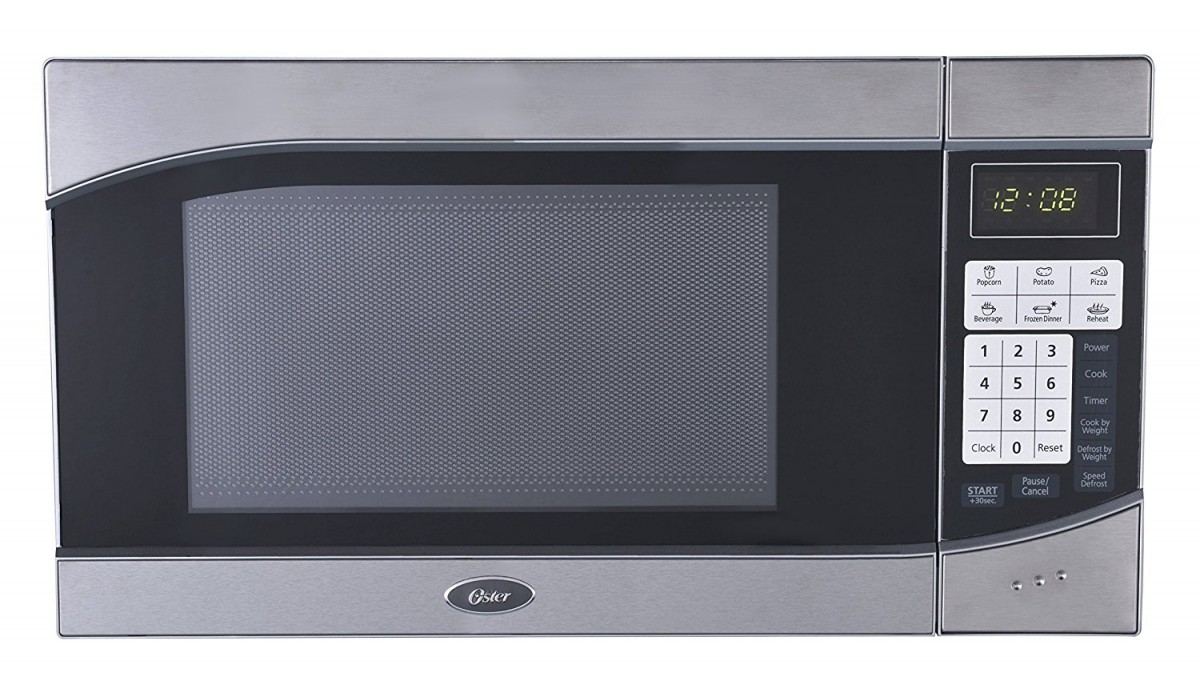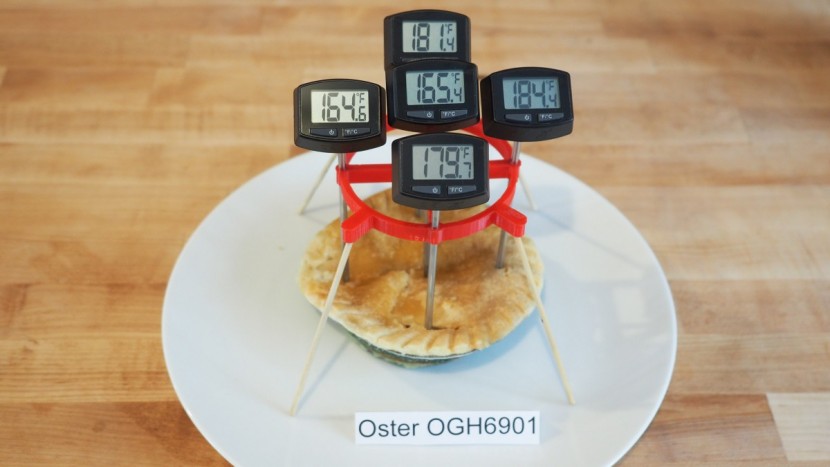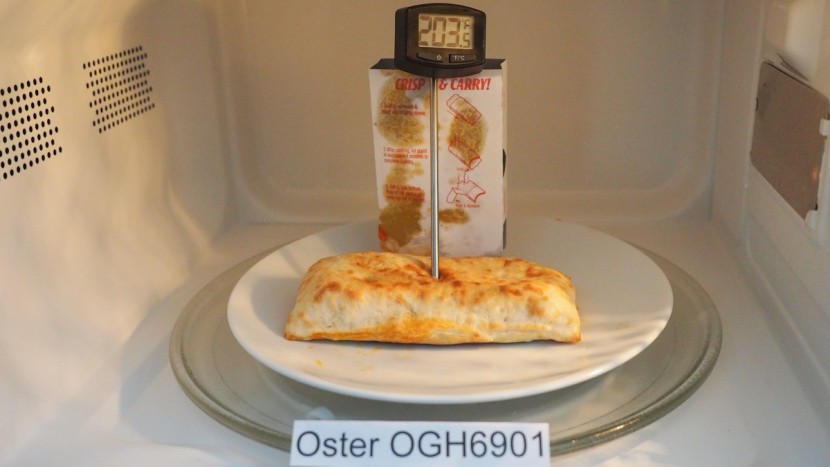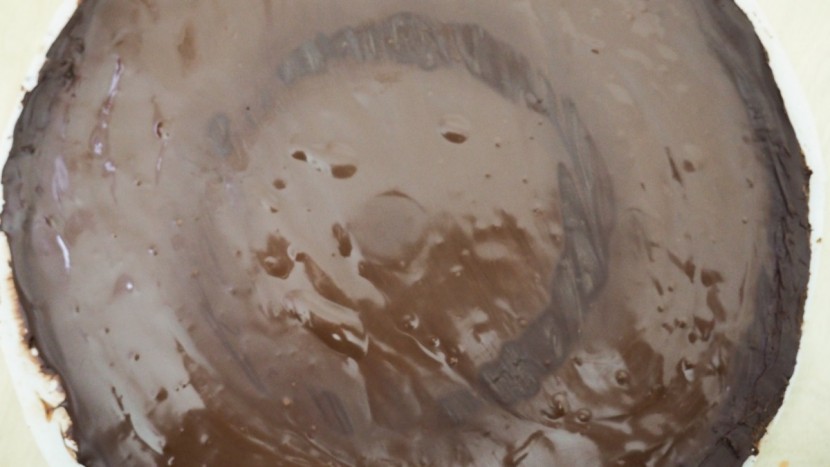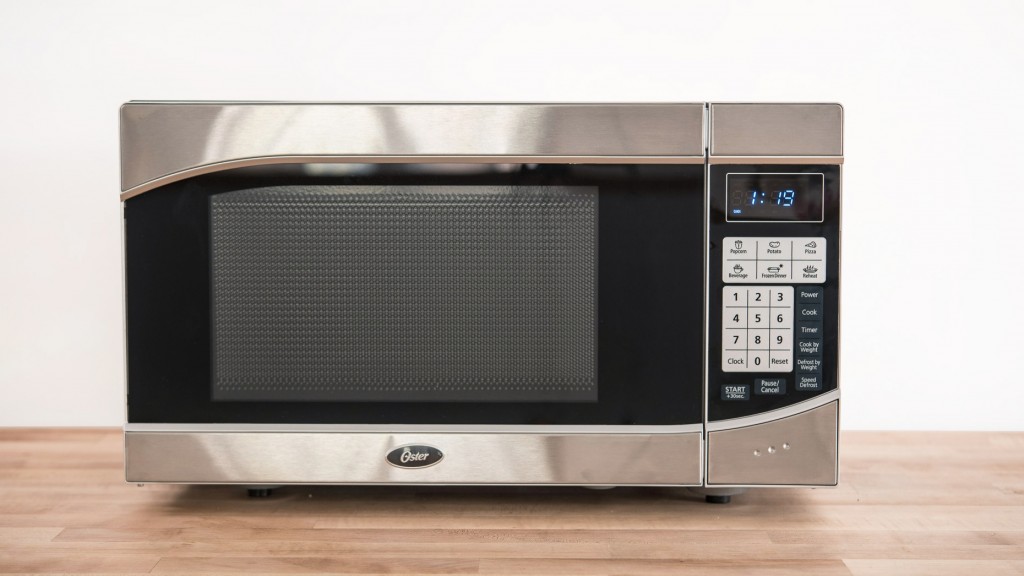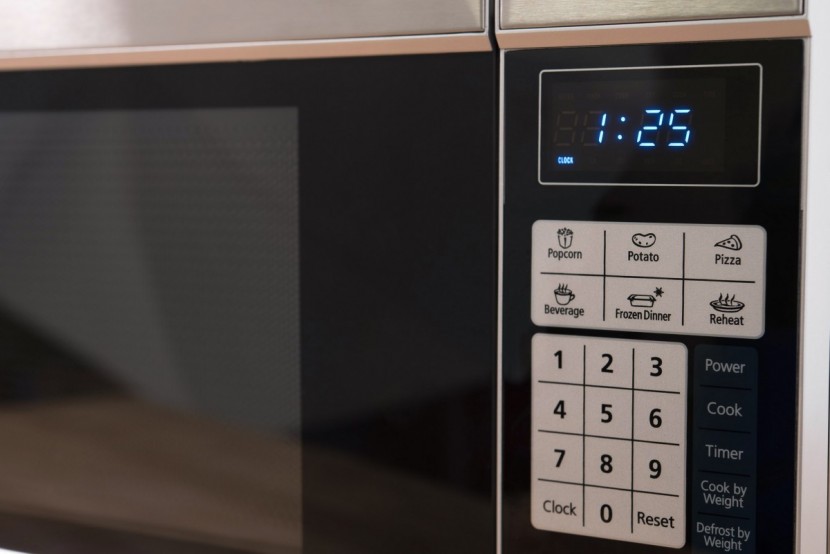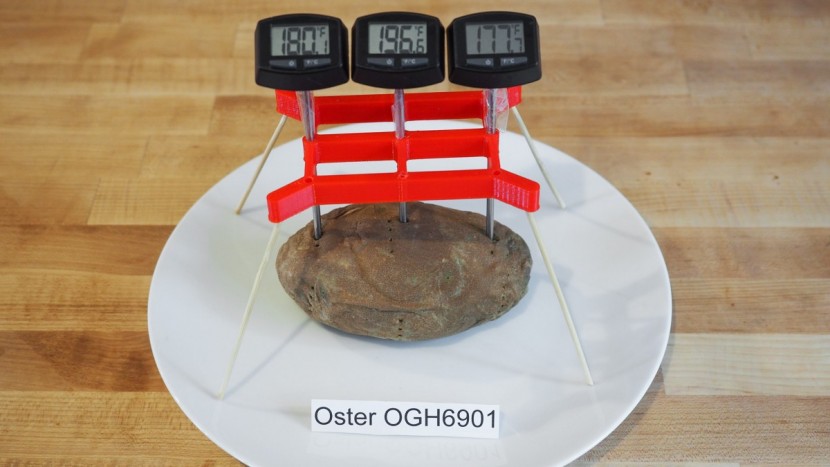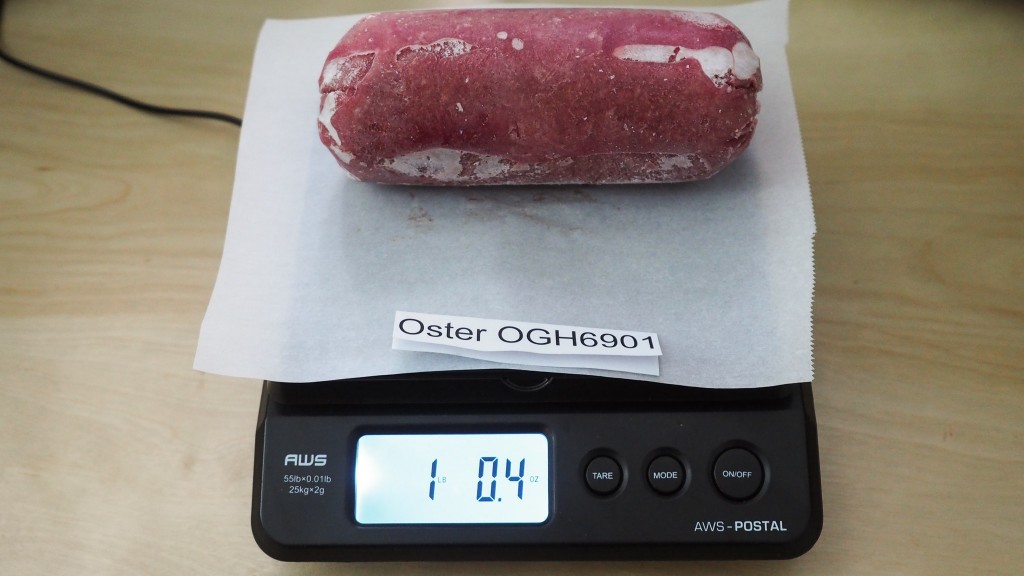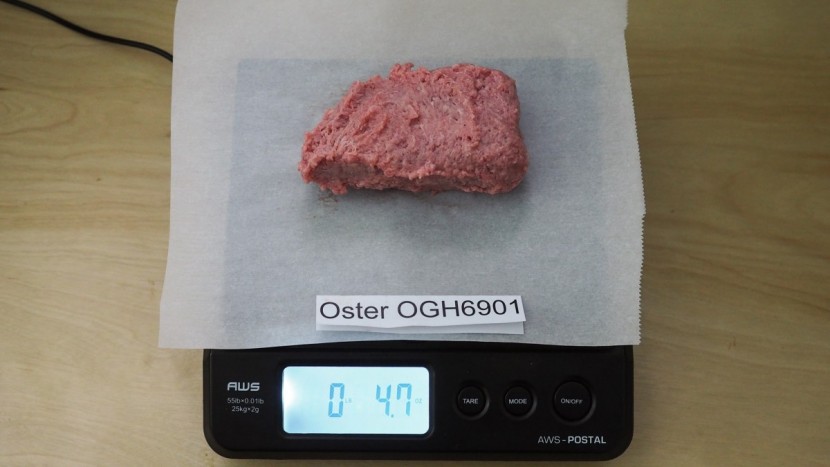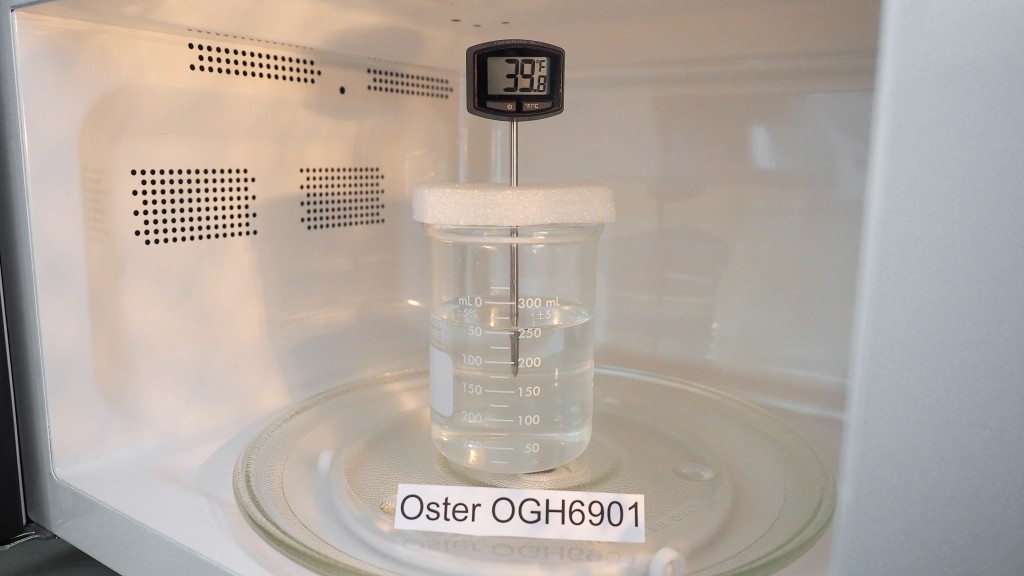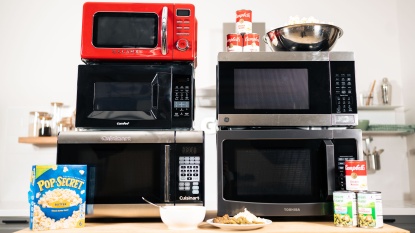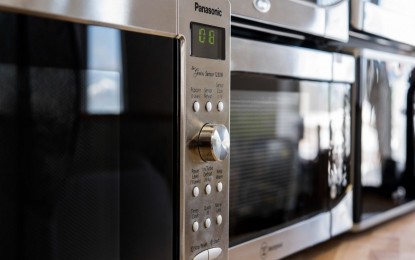Oster OGH6901 Review
Our Verdict
Our Analysis and Test Results
While the Oster didn't impress us too much, it didn't really disappoint us either. This model did exceptionally well at heating up frozen lasagna and plates of leftovers, had reasonably effective preset buttons, and wouldn't slide around on the counter. It's not the best you could choose, but it probably wouldn't let you down.
Heating
This was the highest-weighted and most important metric of our test, making up 40% of the total score. We used an array of kitchen thermometers to assess how evenly each product heated up lasagna, burritos, Hot Pockets, a plate of leftovers, and a chicken pot pie, as well as making a heat map to get a visual aid of how each microwave would heat up food. The Oster did above average.
The Oster did a fantastic job at heating up an individual frozen lasagna, tying for the top score with the Kenmore. All of the regions of the lasagna hit the required temperature, as stated by the package directions. In addition, the lasagna was heated very uniformly, with only an average temperature variation of 3.1°F between different zones. This was the lowest temperature variation of the entire group, just barely beating out the Oster's 3.8°F of average temperature variation.
This model also did very well at heating up a plate of leftovers, once again tying for the top score of the group. Our test plate of leftovers consisted of green beans, chicken tenders, and mashed potatoes, all of which the Oster adequately heated up within a few degrees of each other. The only anomaly we noticed was the very outermost edge of the scoop of mashed potatoes was noticeably cooler than the rest, but a quick stir would have fixed that.
Performance dropped a little when it came to heating up a frozen chicken pot pie, with the center just barely being hot enough, only exceeding the minimum temperature listed on the instructions by a single degree. There was also much more temperature variation between different areas of the pot pie compared to the best models, with the Oster having an average temperature difference of 11.6°F — almost double that of the best scoring model, the Panasonic NN-SD745S. The crust also refused to crisp up in the Oster, becoming extremely soggy while being heated.
Performance continued to drop off when it came to heating a frozen pocket sandwich, or Hot Pocket. There was substantially more temperature variation present on the Oster's Hot Pocket than the other models, with the Oster producing an average temperature difference of 9.3°F between the left, right, and center parts of the sandwich. This is drastically more than the other models, with most other models being between 1-5°F average difference.
The Oster boosted its score when it came to the frozen burrito test, earning the third-highest score of the group. All portions of the burrito hit the necessary temperature of 160°F and there wasn't an enormous difference in temperature across the burrito. The average temperature difference was 10.6°F, much more than the 2.2°F of the Sharp and much much less than the whopping 46.9°F average temperature difference of the Samsung MS11K3000AS.
Finally, the Oster did slightly below average in our heat map test. We spread a thin layer of molten chocolate on a carefully trimmed sheet of parchment paper that matched the turntable of each model. After letting it solidify, we heated each disc of chocolate for a minute, looking for even melting and no burnt or cold spots.
The Oster left a small unmelted strip of chocolate around the outside perimeter, similar to the Kenmore, but also burned a small ring, severely impacting its score for such a glaring hotspot.
Ease of Use
Microwaves are entirely based on convenience, and this metric was designed to assess how easy each model in this review was to use. The Oster once again did alright, earning a 6 out of 10.
We tested how effective the preset buttons were, the quality of the keypad, lighting, and quick buttons. We also compared if these products would slide around on the counter when the door was opened or closed, as well as if you could use it as a kitchen timer.
The Oster does have a “+30 Seconds” quick button, but it will not automatically start the microwave. However, pressing the keypad does not work as a quick button — a stark contrast to other models, where pressing “3” will put three minutes on the clock and start the machine. This model has a good interior light, but it was a little hard to see through the door. You can use this model as a timer, even running a separate timer while heating food. The keypad was about average, but we did find it annoying that if you made an error while entering settings, you had to push the reset key to start over.
This model wouldn't slide around on the counter, and had slightly above average effectiveness when using the preset buttons. We tested by making a bag of popcorn and baking a potato using the preset buttons, and comparing the quality of the finished products between different machines. The Oster did better at baking the potato than popping the popcorn, evenly baking the potato throughout, and having only about 12.7°F of average temperature variation.
The popcorn produced was slightly overdone, being very dried out and tasting just a tiny bit burnt. It did pop the majority of the bag.
Defrosting
To test this metric we used the defrost by weight option to see how well the machines fared. We defrosted a 1 lb log of ground turkey and a bulk muffin that we froze over 24 hours to assess the scores for this metric. The Oster once again performed above average, earning a 6 out of 10.
This model actually did very well at defrosting the roll of ground turkey, with 11.4 ounces being completely defrosted, and the remaining part being relatively easy to break apart.There were a few warm spots, but nothing that was completely cooked.
It did a little worse with the frozen muffin, heating it very unevenly. The bottom was exceptionally hot, the side lukewarm, and the top cold, with no melted chocolate chips. This model did get a few points for having a speed defrost setting, where you manually enter a time instead of a weight.
Speed
The best microwaves heat food quickly, and this final metric reflects that. We used water that had been chilling in the refrigerator, filled a beaker with 250 mL, heated it for 30 seconds, and then recorded the temperature rise. The Oster did about average, earning a 5 out of 10. This model boosted the temperature of the water by about 34°F, a few less than the best model.
Value
The Oster is a good, not great value. It cost a little more than the Best Buy award winners, and performed a little worse.
Conclusion
The Oster is a solid microwave that won't disappoint, though it wouldn't be our first choice. It would be a great option if you are shopping on a budget and either the Best Buy award winners are sold out, or if this model is on a great sale.


